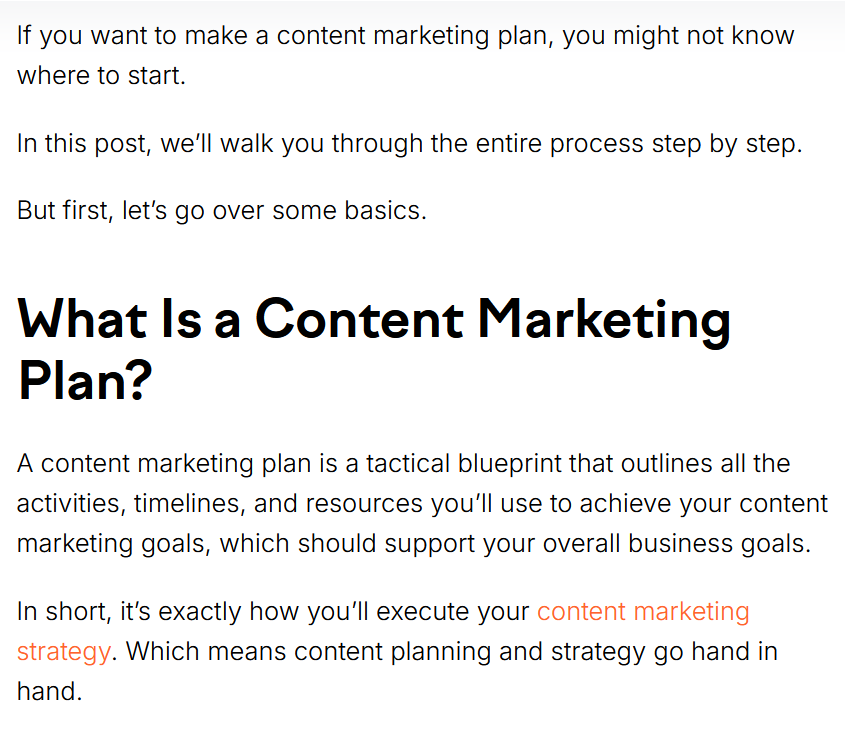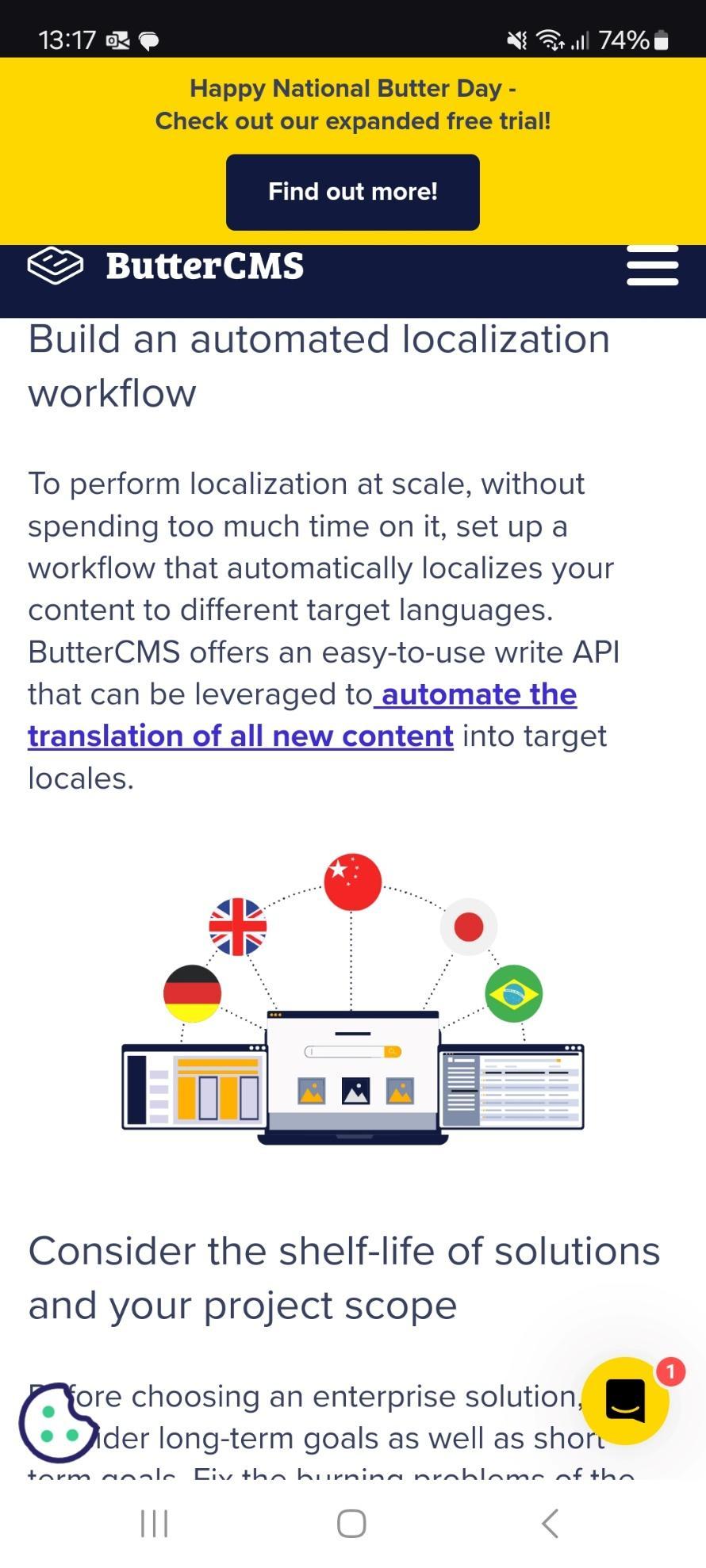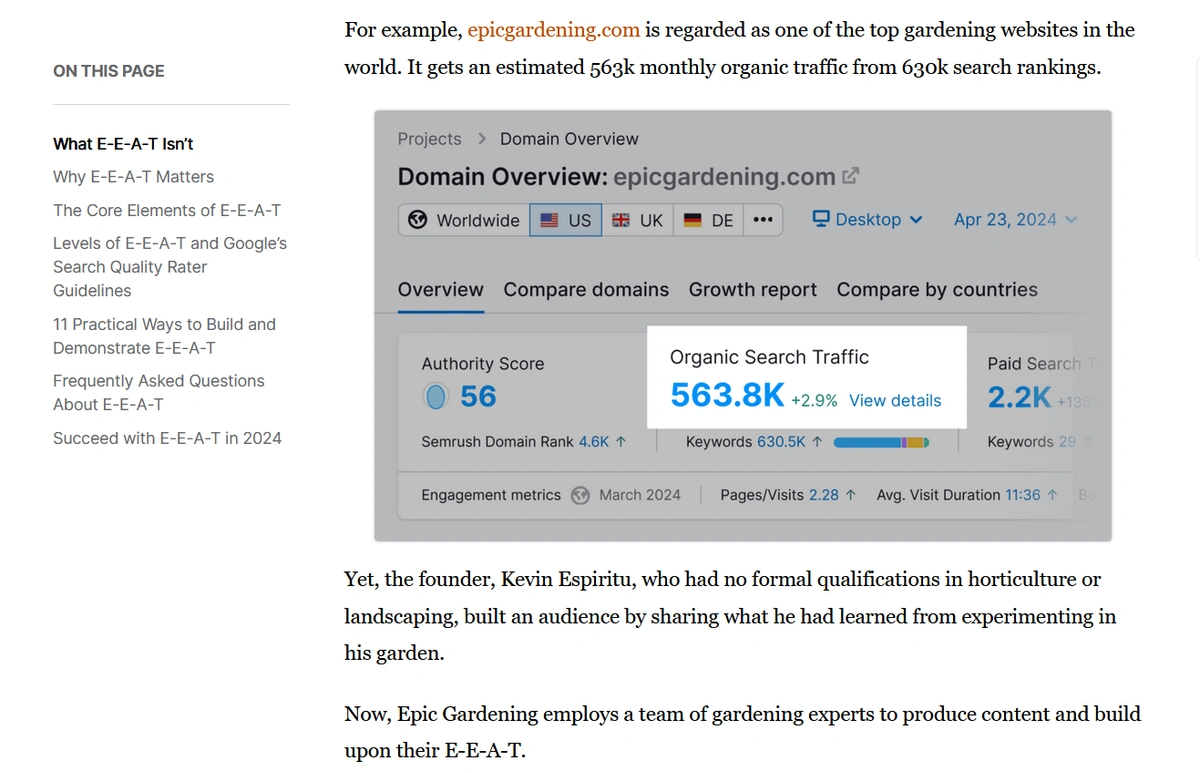- Understanding content-centric SEO
- Why content-centric SEO will be more crucial than ever in 2025
- 5 steps to building a content-centric SEO strategy
- Balancing content quality and optimization
- Enhancing user experience through content
- Establishing trust and authority
- Content-Centric SEO FAQs
- Final Thoughts

GSD
Content-Centric SEO: The Key to Driving Long-Term Organic Traffic
Posted by Maab Saleem on January 22, 2025
Content-centric SEO is a digital marketing technique that prioritizes high-quality, relevant content as the foundation for attracting and retaining organic traffic.
Content is, and always has been, at the heart of every successful SEO strategy. While technical SEO, backlinks, meta tags, and URL structures all have roles, the content truly engages users, answers their questions, establishes authority, and builds trust.
Even the best-optimized sites can struggle to rank without well-written, value-rich content. This is because high-quality content that aligns with user intent continues to be the biggest factor in Google's ranking algorithms.
Businesses must adopt a content-centric SEO strategy that focuses on what users care about—valuable, relevant, and well-structured information to stay competitive. This user-first approach improves rankings, attracts the right audience, and increases engagement.
Table of contents
Understanding content-centric SEO
Content-centric SEO is a strategic approach in which high-quality, user-focused content is prioritized as the main driver for search engine visibility. Unlike other SEO strategies that rely on technical adjustments or off-page link-building, content-centric SEO emphasizes the importance of creating valuable content that meets the needs and interests of users.
For example, technical SEO focuses on optimizing a website’s infrastructure, such as improving page speed and structuring metadata for better crawlability. While important, these adjustments support rather than replace great content.
Similarly, off-page SEO centers on building a website’s authority through external factors like backlinks, social signals, and partnerships. It works best when combined with high-quality content that naturally attracts links and shares.
Components of content-centric SEO
Here are the key components of a content-driven SEO strategy:
-
Keyword research: Identifies the words and phrases your target audience uses to search for information. Through effective keyword research, you can ensure that your content answers relevant queries and meets search intent.
-
Audience alignment: It’s also important to understand who your audience is, their needs, and how they consume content. Content should be tailored to resonate with your readers.
-
Value-rich content creation: After identifying the right keywords, and understanding your target audience, produce content that offers actionable insights, solves problems, and keeps readers coming back. This can include blog posts, guides, videos, and more. Moreover, use headings, subheadings, bullet points, and other elements to improve readability and navigation for both users and search engines.
-
Content freshness: Regularly update and repurpose content to keep it relevant and maintain its value over time.
Why content-centric SEO will be more crucial than ever in 2025
As the digital landscape continues to undergo paradigm shifts, content-centric SEO is set to become an even more critical strategy for businesses looking to secure sustainable organic traffic. Here are the key reasons why:
1. Changes in SEO algorithms
Search engine algorithms are constantly enhanced to provide users with the most relevant and high-quality content. Recent updates increasingly value content that exhibits experience, expertise, authority, and trustworthiness (E-E-A-T). This means that superficial content or keyword-stuffed pages are less likely to rank, while well-researched, in-depth, and user-focused content gains more visibility.
2. Shift in user expectations
AI-generated content is everywhere, and users have become more discerning. Many are now frustrated by generic, robotic, or low-quality text, seeking content that feels authentic and human instead. This sentiment is shared by marketers, with 60% expressing concern that generative AI content could tarnish brand reputation. A content-centric approach helps address this challenge by promoting storytelling, personalization, and deep research to produce content that genuinely resonates with readers.
3. Demand for deeper engagement
AI tools have reduced the barriers to the online market – it’s easier than ever to build and launch websites and add content to them. As the competition grows, content that fosters interaction—such as long-form articles, videos, thought-leadership pieces, or interactive infographics— has become a must. A content-centric SEO framework provides value that encourages users to spend more time on your site, share your work, and keep coming back.
4. Long-term organic traffic
Content-centric SEO is a long-term strategy to drive sustainable organic traffic to your website. When you create content that is evergreen and continues to provide value over time, you can attract visitors consistently, even years after publication. Moreover, since content refreshes are also part of this strategy, you can update outdated content, add fresh insights, and optimize for emerging keywords.
5 steps to building a content-centric SEO strategy
A content-centric SEO implementation requires a structured approach that puts users first while optimizing for search engines. Follow these steps to lay the foundation for long-term success:
Step 1: Conduct in-depth audience research
Use the following methods to understand your audience at a deep level:
-
Surveys and interviews: Use tools like Typeform, Pollfish, or SurveyMonkey to gather insights directly from your audience.
-
Analytics: Study website traffic patterns and user behavior through a tool like Google Analytics.
-
Social listening: Monitor social media platforms like X (Twitter) or LinkedIn to identify trending topics and pain points.
The better you know your audience, the more effectively you can create content that meets their needs.
Step 2: Comprehensive keyword research
Keyword research connects your content to the queries your audience is searching for. Zero in on:
-
High-intent keywords: These are keywords that indicate a strong purchase intent or a desire for detailed information, such as “buy,” “best,” or “how to.”
-
Long-tail keywords: Capture niche audiences by targeting specific, low-competition phrases.
Use tools like SEMrush, Ahrefs, or Google Keyword Planner for your keyword research.
Step 3: Craft content around user intent
Your content should always address the intent behind a user’s search query. For example:
-
Informational queries: Create how-to guides, FAQs, or explainer articles.
-
Transactional queries: Offer product comparisons, reviews, or landing pages.
Remember to write for humans first and search engines second. Engaging, readable content will naturally perform better.
Step 4: Create a content calendar
Consistency is key to a successful SEO content strategy. Use a combination of the following tools to plan your content creation strategies and publishing schedule:
-
Google Calendar to track important dates and deadlines.
-
ButterCMS for streamlined content management and scheduling.
Step 5: Refresh your content
Last but not least, regularly review and update existing content to keep it relevant and accurate. Some refresh strategies you can use are:
-
Adding updated statistics or examples.
-
Improving outdated SEO elements like metadata.
-
Repurposing content into new formats, such as turning a blog post into a video or infographic.
-
Using the latest versions of software/tools in your tutorials/guides.
Balancing content quality and optimization
A successful content-centric SEO strategy strikes the right balance between content quality and content optimization. Focusing too much on one at the expense of the other can hurt your chances of driving sustainable organic traffic. Follow these tips to achieve the right balance:
Tips for high-quality content creation
-
Avoid generic or duplicate content. Offer unique insights, perspectives, or data that set your content apart.
-
Use a tone and style that resonates with your target readers. Understand their pain points and address them directly.
-
Your content should solve problems, answer questions, or provide actionable advice. Aim to leave readers feeling informed and satisfied.
-
Use storytelling techniques for audience engagement and to make your content more memorable.
-
Break up text with headings, bullet points, and short paragraphs.
-
Use visuals, like images or infographics, to make content more immersive. There are plenty of (free and paid) multimedia resources you can consider.
-
Ensure that your brand voice and messaging stay consistent across all content pieces and platforms. An omnichannel CMS like ButterCMS can be helpful in this regard.
SEO best practices for optimization
Here are some SEO best practices to remember:
-
Incorporate primary and secondary keywords naturally into your content, including introductions, headings, meta descriptions, and image alt text. Avoid keyword stuffing.
-
Write compelling title tags and meta descriptions that include your target keywords and encourage clicks.
-
Add descriptive alt text to your images to help search engines understand their content.
-
Use internal linking to interlink related content on your site. This improves navigation and distributes link authority.
-
Make your content mobile-friendly, as search engines consider mobile usability in rankings.
-
Monitor content performance using tools like Google Search Console. Regularly update outdated or underperforming content to maintain relevance.
A great example of the right balance between content quality and SEO-driven optimization is this blog post, “How to Create a Content Marketing Plan in 7 Steps,” from the SEMrush blog. Consider its introduction:
The introduction is a prime example of high-quality content because:
-
It’s straightforward and easy to understand. It quickly establishes the topic and goal of the post.
-
It acknowledges a common pain point and offers a solution.
-
It provides a clear definition of the main concept.
But that's not all. This introduction is also SEO-friendly:
-
The primary keyword "content marketing plan" is used in the first sentence and H2 heading.
-
Secondary keywords like "content marketing strategy" are incorporated naturally.
-
An internal link is used to direct the reader to a complementary resource.
This balance of quality and optimization continues throughout the entire post, making it a great example of content that’s loved by readers and search engines.
Enhancing user experience through content
User experience (UX) plays a fundamental role in SEO success. Search engines like Google assess UX signals such as time spent on a page, bounce rates, and click-through rates when ranking content. Here are some tips to optimize UX:
-
Ensure that your website is responsive and adapts to different screen sizes.
-
Use techniques like the following to boost site speed:
-
-
Optimize images and reduce file sizes.
-
Minimize HTTP requests.
-
Leverage browser caching.
-
Use a reliable hosting provider.
-
Use a scalable, headless content management system (as opposed to a traditional one).
-
-
Create a clear, intuitive navigation menu. Use clear and concise labels for menu items.
-
Use schema markup to help search engines understand your content.
-
Simplify complex information with easy-to-read graphics that summarize key points. Infographics are also highly shareable, which extends your content’s reach.
-
Elements like quizzes, calculators, or polls can encourage users to interact with your content and create a more memorable experience.
-
Use high-quality images to break up text and illustrate your points.
A great content-centric SEO example of a blog post with good UX is this blog post, “Enterprise Content Management Challenges and How to Avoid Them,” from the ButterCMS blog. Consider this screenshot of the post taken from a mobile phone:
As you can see:
-
The text is well-formatted and easy to read on a mobile device.
-
A high-quality image enhances the content and breaks up the text.
-
Headings guide the reader through the content and improve readability.
-
The menu is accessible from the top right corner, allowing visitors to easily navigate to other pages as needed.
Establishing trust and authority
Another critical aspect of a content-centric SEO strategy is establishing trust and authority. When your audience views your brand as credible, they’re more likely to engage with your content, share it, and return for more. Here are some tips in this regard:
Share original research, expert opinions, and case studies
Publish unique studies, surveys, or industry reports to demonstrate expertise and provide valuable insights that others can reference. Collaborate with industry leaders to create interviews, guest posts, or Q&A articles that add depth and authority to your content.
You can also use case studies to showcase real-life examples of how your products or services have solved problems for customers. These validate your offerings and make your content more relatable.
Be transparent and accurate
Always back your claims with data from reputable sources to enhance trust. If your solution or advice has limitations, be upfront about them. Remember, honesty builds long-term credibility.
Measuring content success
Evaluate how your content is performing to ensure it is resonating with your audience and building authority. Focus on metrics like:
-
Backlinks: The number of high-quality websites linking to your content is a strong indicator of credibility.
-
Engagement rates: Track metrics such as time spent on a page, bounce rates, comments, and social shares to gauge audience interest.
-
Conversions: Measure how effectively your content drives users to take desired actions, like subscribing or making a purchase.
Provide practical value
Create content that solves problems or answers common questions. When users find your content genuinely helpful, they’re more likely to trust your expertise. Examples include:
-
Step-by-step guides or tutorials.
-
Toolkits, checklists, or downloadable resources.
-
FAQs addressing specific pain points.
A great example of an authority-establishing piece is this blog post, “Google E-E-A-T: How to Create People-First Content (+ Free Audit),” from the Backlinko blog. Consider this screenshot of the post:
As you can see:
-
The author supports their claim with a relevant industry example and data.
-
The post covers everything a reader would like to know about E-E-A-T, including the basics, why it matters, real-life examples, practical implementation specifics, FAQs, and the latest updates for 2024.
-
The title itself promises a free audit, showcasing the author’s authority and willingness to provide value to their readers.
Content-Centric SEO FAQs
What role can AI play in creating and executing content-centric SEO strategies?
AI can be a helpful tool in content-centric SEO when used wisely. For example:
-
AI tools can analyze trends and user behavior to suggest topics that resonate with your target audience.
-
AI can identify high-performing keywords, analyze competitors, or find content gaps.
-
AI-powered tools like Grammarly or Surfer SEO can improve readability, structure, and keyword usage.
-
AI can help create tailored recommendations or dynamic content based on user preferences and behaviors.
However, AI should support human creativity, not replace it. Always prioritize quality, originality, and human connection when producing content.
What techniques should be avoided when implementing content-centric SEO?
Here are some techniques to avoid:
-
Keyword stuffing: Overloading content with keywords harms readability and can lead to penalties from search engines.
-
Over-Optimization: Excessive focus on SEO elements (e.g., forced keywords or unnatural headings) can make content robotic and disengaging.
-
AI-powered content generation: AI tools often generate content that is similar to existing content, which can dilute your brand's voice and reduce its impact.
Can content-centric SEO be combined with performance marketing?
Yes. Here are a few examples:
-
Use content to educate and nurture leads, then drive conversions with targeted performance marketing campaigns.
-
Use high-value content, such as blogs or whitepapers, to retarget users who’ve engaged but haven’t converted.
-
Insights from SEO analytics can guide performance marketing strategies, while ad campaign data can inform SEO priorities.
Final Thoughts
In today’s competitive online environment, adopting a content-centric SEO strategy is crucial for success. By prioritizing high-quality, user-focused content that aligns with search intent and works alongside technical and off-page SEO, businesses can build trust, establish authority, and attract long-term organic traffic. This approach not only satisfies search engine criteria but also meets the rising expectations of readers who value authenticity and relevance.
To explore how you can effectively combine SEO-centric content with performance marketing to drive results, check out the official ButterCMS podcast Cutting Edge: Web Content Development episode 26 “Blending SEO-Centric Content with Performance Marketing” featuring John Hutson of Ink Digital. Listen today to elevate your strategy!
ButterCMS is the #1 rated Headless CMS
Related articles
Don’t miss a single post
Get our latest articles, stay updated!
















Maab is an experienced software engineer who specializes in explaining technical topics to a wider audience.